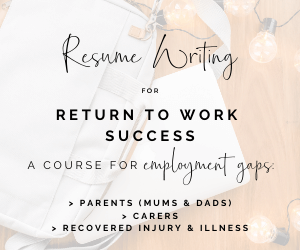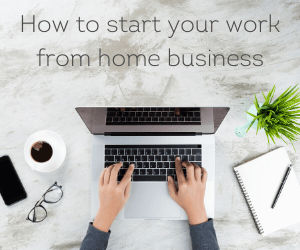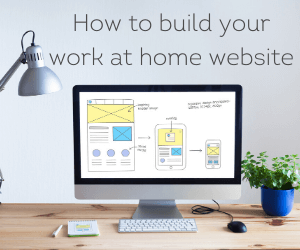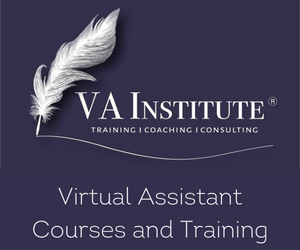Have you ever read a blog and thought “I would love to be able to do that” but had no idea how to start a blog yourself? Blogging is becoming more and more popular. There are literally millions out there from people around the world covering almost every topic imaginable. Each one has something unique to offer and resinates with a different audience, so although you might think you’ll never find your niche, or there’s so much out there already, you just need to find your tribe that wants to hear what you want to say.
Creating a blog is not hard. It does take some time, however there are some main steps to follow to get you up and running.
- Step 1: Choose what to blog about
- Step 2: Choose a blogging platform
- Step 3: Choose a blog name and domain
- Step 4: Choose your hosting
- Step 5: Make your website look good
- Step 6: Learn about SEO
- Step 7: Start creating
Work at Home Mums has been going for 11 years, and yes, it is a blog. It’s evolved and changed and definitely grown over the years, but it essentially started out as a small blog like the one I’m about to show you how to start.
Why start a blog?
There are lots of reasons people choose to start a blog. Whether it is just because they like writing and have a topic they are passionate about or to evolve their blog into something that makes money there are many reasons to start. A few more common ones are:
- You like writing. Even if it has nothing to do with your day job, some people just want to write. You might have a topic you love, a story to share, or want to encourage others and a blog is an easy way to do all that.
- Make money working from home. If you have a blog about something people are interested in and start to get a bit of traffic, blogs can be a way to earn money while working from home. This can be either a few hundred per month to a full time income for the serious bloggers.
- Get more exposure for your business. You might have a business you think is unrelated to blogging. But blogging about your product or service is a great way to reach people and let them know about what you have to offer.
How to start your blog
Step 1 – What to blog about
The first step is to decide what you want to write about. Obviously pick something you are passionate or interested in as well as knowledgeable about. Your interest will show through in your writing so if you are just writing for the sake of it rather then the love of the topic, your readers will know.
Choose something that has a lot of things you can write about. Blogs need a lot of content so if you are too specific in your niche you will run out of things to discuss pretty quickly. And if you want to make money from your blog then you need to find that great spot between what you want to write about and what people want to read about. If you can find that niche, you are well on your way.
Your main aim should be to become the go-to resource for your topic.
Step 2 – Choose a blogging platform
There are many ways you can build a website these days. Platforms such as Wix, Blogger, Weebly and Sqarespace are good, but if you want to monetise your blog then I don’t recommend them, especially not the free versions. I will tell you why in a second.
WordPress is by far the most popular platform to use these day but there are two ways to use it, WordPress.com and wordpress.org. If you want to really take your blog and run with it, I recommend wordpress.org. Why? Well wordpress.com as well as other free (and some paid) versions of the other platforms I mentioned have advertising on them to keep the costs down for the users. This is great if you just want to write a bit about your topic for fun as it means you’re not outlaying anything for your website, however if you are wanting to make money from your blog, then these platforms make it very difficult for you to place any advertising you want. After all, they are making money from their advertising, they certainly don’t want yours.
A lot of the free platforms will also limit your ability to have your own domain name. It will look something like yourblog.wordpress.com or yourblog.blogger.com. Which can look really ugly and is not great for branding. You also don’t own your blog on these sorts of sites. You’re blog can be deleted any time as it’s hosted on someone else’s private company property.
For these reasons, I recommend a self-hosted WordPress site, which will cost a little bit of money (but not actually very much at all) and will give you much more control over your blog. The rest of this article will be as if you have chosen to go with a self-hosted wordpress.org site.
Step 3 – Choose a blog name and domain
You’ve chosen your topic so now you need to choose a name for your blog. It can pretty much be anything you want but ideally if someone stumbles across your blog along the way, they get an idea of what it’s about in the name. Work At Home Mums, for example, is fairly obvious who the site is for and what its about. If you were writing about family budgeting you could choose a name like The Budget Mum, as an example.
Next you need to figure out if that name is available. A great resource for this is namecherkr which is a site where you can put in the name you are thinking about and it will tell you if the domain name is available as well as all the social profiles. (Even Myspace. Does anyone still use Myspace?)
Incidentally, I used thebudgetmum to check the site and it was available at the time of me writing this so if you go on to steal that idea give me a shout out when you’re a famous blogger.
Last but not least, check for trademarks on your chosen name. There is nothing worse then setting up your brand and having to start again and change everything because you’ve infringed on a trademark.
Once you’ve found a name you love that’s available, purchase the domain name. You can do this through a registry like Crazy Domains. There are a variety of options to choose from but the most common are the .com or .com.au. Ideally you’d like to have your domain name the same as the name of your site or your business name.
Step 4 – Choose your hosting
To use WordPress, you need to self-host, which means you can choose who you want to host your website through. For a beginning blogger, it’s good to go with someone reasonably cheap but reliable. Some good, relatively inexpesive hosting companies are Bluehost and Hostgator however my personal favourite is Siteground. All are well known hosting companies and their base level plans are great for starting bloggers.
I will say that it is generally better to go for a yearly plan rather than month to month. It’s cheaper, and generally less hassle to pay for a year up front rather than small increments coming out of your account each month. Also remember the longer period you go for, the cheaper it can be. It will take a few months to get your blog up and running with traffic, so most people really need 6 months to a year to figure out if blogging is for them.
Once you’ve got your hosting sorted you need to install WordPress. If you go for one of the companies we’ve suggested, then this is usually pretty easy as they have a quick install button for installing WordPress and getting your site up and running.
Step 5 – Make your website look awesome!
Now the fun part begins! It’s time to start designing your website.
WordPress is a platform that you can do pretty much whatever you can think of design wise, but to do it you need a theme. WordPress does come with some standard default themes but (you can find them if you click on Appearance > Themes). There are also a lot of free themes available on wordpress.org or just google ‘free wordpress theme’.
Like most things, sometimes it pays to get a little bit more and there are a multitude of paid themes that tend to allow you more freedom and versatility of design then their free counterparts. I personally love the Divi Theme from Elegant Themes (my go to when I’m designing a site) because it gives you so many design elements to do whatever you can imagine with your site. There are also many other sites out there such as Theme Forest and Creative Market where people have designed themes for you to install.
When choosing a design for your website and a theme, think of what you would like to see if you were a reader coming to your blog. Try to keep your website clean and easy to read. Sometimes simple really is best. It should be easy to navigate and find what people are looking for. If it’s tricky and difficult people won’t stick around for long, no matter how great the content is.
Step 6 – SEO is crucial
When it comes to building your blog’s success, it’s important to take SEO seriously. SEO is Search Engine Optimisation, which is the process of making your blogs, articles and website pages able to be read and ranked in search engines such as Google. SEO is a key aspect of building a sustainable website, because in order to rank effectively in search engines and get found by people searching for what you do, SEO is required.
You can learn about SEO and do it yourself, or there are many places you can employ to do it for you. Even if you pay someone else to do it for you, its important to at least learn the basics so you know what questions to ask and what they are trying to do to your website. A great place to start learning the basics is the free SEO Nibbles course run by Kate Toon. It’s important not to overlook learning at least the basics about SEO, unless you know what you’re doing, you could make some fatal mistakes that have a far-reaching impact on your blog’s success.
Step 7 – Start creating
Literally, just start. Play around with your website design. Create a logo. Start writing your blogs. Things don’t have to be perfect at first and the more stuff you do, the more you’ll learn. The most important thing is to enjoy it because that is why you wanted to start in the first place right?
If it all seems a bit overwhelming, try our How To Build Your Work At Home Website course. It takes you through step by step how to design and create your website, as well as some things you can do to monetise it as well.
The important thing about creating content with your website is to keep it consistent. Make sure you’re publishing articles at a consistent time. You won’t keep readers if you publish 3 articles in one week and then they don’t hear from you again for 3 months. You can choose to write as much as you want in a small amount of time if that helps you, but make sure you are publishing them at a consistent pace.
Other things to consider
Branding – If your blog takes off, you want to have a good brand behind you, including a logo. Our article on why your startup needs a branding strategy is a good starting point for this.
Photos – All blogs will need photos as they help break up all the text (and they just make it look pretty). And if you’re not going to take them yourself you cannot just randomly take photos off the internet (well, you can but you’ll be hit for copyright and that will make your cheap to start blog very expensive). We use Deposit Photos for our stock images.
How’s your grammar? – Unless you did a degree in English (I know one person who did and I still ask him to this day if it was useful) most of us won’t be perfect writers. Lucky for us the internet has this covered too. Grammarly is a instant grammar checker to help make your writing the best it can be.
How to make money from blogging
In terms of actually earning an income from your blog, it’s essential that you understand how this process works. A key factor is to make yourself easily reachable. How do you do this? By ensuring that each of your blog’s social media channels include easy-to-see contact information, such as a dedicated email address, for instance.
Blogging seems to offer the promise of easy money, meeting lots of people, being offered free products, and all whilst sitting in your pyjamas at home on a Sunday morning. In practice, many find it’s a daunting and chore-like exercise in futility and frustration. It’s also essential to understand that even with a perfectly designed blog, it still takes time to build up your following and grow your blog. Your blog only becomes valuable financially when you’ve actually grown it, which is why you need to spend some time doing that.
If you’re asking how to earn money from home by blogging then there are some basic things to think about first.
You need traffic
There is simply no way to earn money from home by blogging without people visiting your site. It doesn’t matter what income streams you have working for you on your website, if there is no one reading your stuff, then it’s all for nothing. There are many ways you can get traffic to your site, some of the most common and proven methods are:
- SEO – optimise your site so it comes up in Google searches for keywords relevant to your website. This is known as organic traffic.
- Social media – sites such as Facebook, Instagram, Pinterest and others can be great drivers of traffic to your site. You need a good strategy though, and to make sure you are posting relatable, engaging content regularly.
- Guest blogging on other sites – a way to build some trust and engage your target market is by creating blogs and getting them published on other websites. If you can get your blog published on other platforms, they will usually have an “about the author” section and/or a link to your website. Which means anyone reading what you have written has a direct path to find out more about you and read all the fabulous content you’ve put up on your own blog. Instant traffic.
- Email marketing – One of the most important things you can do is create an email list. This can be a great way to get repeat traffic as if someone has signed up to your email list they are already interested in your topic and what you have to say. This is the only audience you can market to that you own. Social media, blogging on other websites etc can be deleted or removed in an instance.
- Directory listings – Some sites have directories you can list on that target specific markets (look at WAHM’s Mum’s Marketplace as an example). If you have a service or product on your blog you would like to offer, then directory listings in your niche can be a good way to get traffic from your target market.
- Advertising – an option that will cost you money but can be very effective. You will need to target your audience well if you don’t want to spend a lot of money, but advertising on things like Facebook and Google can have a good return on investment due to their niche targeting algorithms.
Monetise your site
There are ways to make money off your blog without having to sell your soul. Use your site to generate content that you can use to increase the popularity of your brand, THEN sell advertising for other companies or you can sell your own products and services. Ways you can use your site to earn money are:
- Advertising – use your website to advertise goods and services for other people either through direct advertising and banner ads or pay per click advertising such as Google Adsense.
- Affiliate marketing – you sell an advertiser offer on their behalf. You direct traffic to their website through a specific link and if they make a purchase then you’ll get a percentage of the price.
- Influencing / sponsored posts – as an influencer, you’ll have the opportunity to use your social media sites and your website to promote the products and services of others.
- Information products – E-learning is a big income opportunity. Things like e-books and courses are great ways to monetise your site.
- Consulting and services – Are you an expert in your topic? Use the skills you have to create your service.
- Directories – target a specific niche and sell listings on your website. There are directories for web designers, freelancers, small businesses, mum blog sites – anything you can think of could have a directory for it!
Blogging can be a fun, inexpensive way to impart some knowledge on a topic your passionate about and learn some new still. It can also be a good way to earn some extra money on the side of your day job, or even expand it to be your main source of income.
Disclosure: Some of the links in this post are ‘affiliate links.’ This means if you click on the link and purchase the item, we will receive an affiliate commission, however we don’t recommend anything we haven’t used.






